1980/2010 Giovanni Imbalzano Lulu © The magic history of the Holy Shroud
From the first of centuries!
1° MILLENIUM: Constantine VII, Omar I, Baradeus, Bar Daisan, Mar Aggai, Abgar V... AND:
Implicit Documents
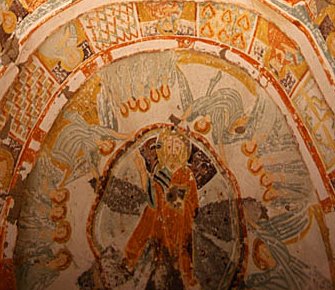 "Daniel=Agaçalti"
"Daniel=Agaçalti" Delivery
of the Cloth:
Delivery
of the Cloth: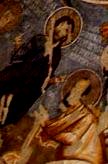 the
stole is a Tetradiplon!
the
stole is a Tetradiplon!
Vault of S. Daniel church, restructured in the IX century to 100 meters of
depth, and details of Karanlik Kilise, a memory of the IV century.
S. Daniel is in the Canyon Ihlara (Anatolia / C) to the east of Lake Çereflikoçhi; Karanlik (= dark) in Göreme Valley, halfway between that and Agaçalti of Armenia, northwest of Lake Van, about 1000 m. In the total inset we can identify six Apostles on the right and five Patriarchs on the left. The four predecessors of Ethalah are precisely Sha'ad, Conon, PALUT and Mar-Aggai, preceded by the Apostles destined for the East: Addaj, Thaddeus and Thomas (directed towards the India) while others three Apostles was for the Georgia (Simon the Zealot, Andrew and Matthew).
In a zone possibly nucleus irradiant, the volcanic church above Lake Van viewed the entire Shroud! To the center, in a monastic garment the Risen Christ represent the time of the first monks of the place; on the left, he reveals a sort of bandages on the wrists, protecting the stigmata observed certainly on the Shroud. Each leakage of blood under the eyes are shaped as a triangle; this is upside down in a non-natural way, adapted to hint at the Trinitarian dogma, that was to be defined in the 381.
But the pendant around his neck is still a David Star with six tips; in fact, in painted symbols, crux was manifested only later. Technique and taste of the painting belong to the ancient Eastern and not to Byzantine traditions, but the star does not is eight-tip as tradition used by artists in this region: that which we see not is therefore merely an ornament. The visible decorations "herringbone" as in the Shroud, here in the corner, are even more visible on the ceiling.
The dedication to the famous interpreter of the visions and the dreams (Daniel 1,17) not is accidental: it recalls the struggle against persecution and idolatry, and still the "Permanent Light" of the Shroud. On the side wall of the church of Karanlik, an Angel received the Pearl "of Daisan" from an Apostle, that hides the white Sheet under the clothes. And history will repeat itself in the 1553: in Vercelli, a canonic (C. Costa) saved the relic, hiding this under the cloak, while "Cossè de Brissac" tried to occupy the Vercelli city of Emanuaele Filiberto, engaged with Charles V in the defense of Milan. Also for this, there was a legend:
"an invisible force was preventing the approach to thievery of the Holy Shroud!" (A.L. Millin, Voyage en Piemont de Lausanne, Ed. Sajou)
Passage of the precious Relic from the Apostles to Patriarches 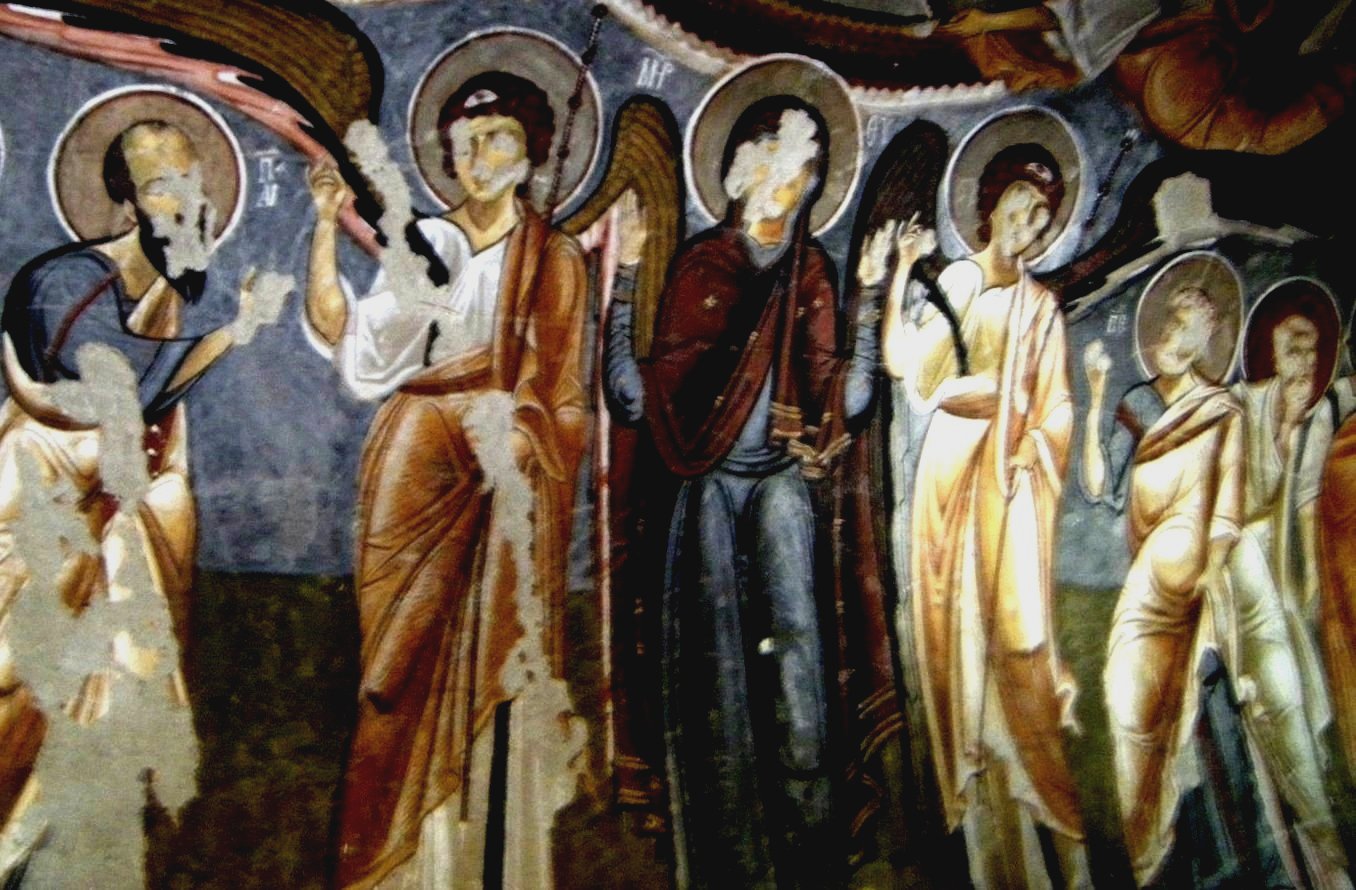 Just like here the great Pearl diminish, the Holy Shroud became a Mandilion!
Just like here the great Pearl diminish, the Holy Shroud became a Mandilion! 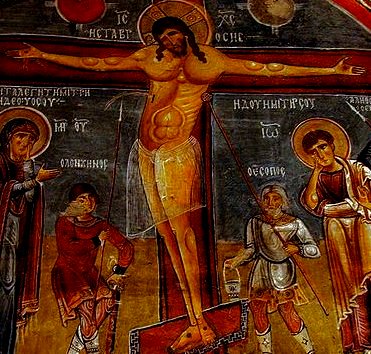
In Arian Baptistery of Ravenna of the sixth century (decorated by the Orthodox) St. Paul show Scriptures on the cassock; for this reason, the Pearl here is not properly a "stone altar" but the Centre itself! In the same Dark church, the crucifix have the wound in the chest right, foot on an asymmetric hassock (not imagining the artist it was used a single nail). The beard is divided into two; we see some intumescences, also at the wrists, because the nails are imagined on the palm, as if to assume here an "hematic hydrosis", and also small drops of blood on the forehead; all this and other is disposed as in the Shroud: the artist had seen properly this, or the Christ! Of annotations above there are documents of the fourth century, for example a comedy that was ascribed Gregory of Nazianzus (384 AC) in the major parts, "Christus Patiens", where the author assert that Jesus was crucified naked with three nails and he after died was deposed with the blood still streaming from the wound to the side, and was enveloped in some towels. The last assertion go back to the Gospel of St. John; the other (of three nails) will be disclosed only in the Middle Ages with the exhibition of the Shroud whole, however, into the 450 AC, this is reported by at least two other writers: Nonnus (Egyptian) and Socrates (Turkish) and this is the proof that the Shroud in the fourth century, though few visible, already is existed. Socrates continued his "Ecclesiastical History" perhaps for a suggestion of Theodore Mopsuestia, disciple of Chrysostom. Nonnus has paraphrased the IV Gospel and he lived to Akhmi'm, where in 447 Nestorius (451) was exiled (he have described the human nature and the godlike nature of Jesus as two distinct subjects).
Nestorius is born in Kahramanmaraç near Nazianzus: from here to the common knowledge of the Holy Shroud the step is short! The same (or another?) Nonnus, monk in Tabenna of the Nile, was the patriarch of Edessa (448-471 ) pending the final decision on Ibas (435-457 ) accused of Nestorianism.
The Nazianzen was an ascetic and often he retreated in hermitage; Bishop of Sasima (at Nyssa, where was the other Gregory) he fought the Aryans, but disgusted by the schism of the 382 he retired to Nazianzus, actual Konya (shown here in the Christian Map) not far from S. Daniel, and it is not a coincidence! Apart from the brilliant Dissertations of S. Cyril of Jerusalem, focused on the Shroud, some strong recalls exist on the Shroud also for St. John Chrysostom (381) St. Gregory of Nyssa (379) Eusebius of Caesarea (325) Epistula Smith & Pope Eusebius (309-335) C-46 of the Liber Pontificalis. In particular, while he acknowledge the existence of the Shroud, the Monophysite Eusebius, an opponent to the exposure of Christ image, he does not furnish information of the "Portrait of Christ" existent in the Archive of Edessa, seen by him thus as Ephrem the Syrian, the author of the "Doctrine of Addai". This is a well known strategy for fights against the Arians, a fight that was emphasized in the fifth century against the Nestorians!
"For a Nail we lost a Horseshoe bat; for a Horseshoe bat we lost a Rider; for a Rider we lost a Message; for a Message we lost a Tower;
for this Tower we losed an Empire, and from the Empire we saved the Shroud" (I'm
blazon of the horse with white markings on its fetlocks, XXI century)
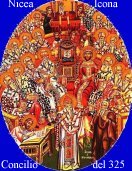
In the Meteoron of M. Athos (1552) and in Sistine Chapel (1590) on the background of the First Council, the Risen appear with the Shroud compressed into the arms, as in other icons of the 325. The Constantine Emperor is in the foreground; in favor of orthodoxy of interpretation of the Four Gospels, he burn the books of the dissidents. Ethalah was present and had some fears, because he had adopted also a different (unified) text: the Diatasseron that was transcribed into the year 172 from an ascetic, the Syrian Tatian, a gnostic that influence the Bar-Daisan. Later Diatasseron was explained by S. Efrem and recommended by Rabbula Patriarch of Edessa (411-435) but it was prohibited from someone, for example the Bishop of Cyrus (423-457) Theodoret, a friend of Nestorius. We mention here an interesting step, on linen woven with "Z" design, of Joseph of Ramah (Arimathea): " ...bought a pure linen fabric twisted, I laid the body of Jesus..." (LII, 24). I reflected the fact that any person which saw the bloody Shroud of the Risen was pushed and conflict, solving himself for the Gnostic idealization or the Nestorius opposite materialization: a half millennium was necessary, to reach a resolution that reconcile Christ "truly God and truly Man, composed of rational Soul and Body..." (Constantinople III, 681); and here we comes to thinking that properly the concept of authenticity (or not) is not appropriate to the Holy Shroud, for as much as it is an object outside of the space and outside of the time!
~
Implicit Documents for
:1° MILLENIUM: Constantine VII, Omar I, Baradeus, Bar Daisan, Mar Aggai, Abgar V..!